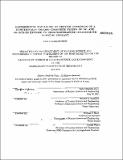Experimental simulation of crevice corrosion of a functionally graded composite system of F91 and Fe-12Cr-2Si exposed to high-temperature lead-bismuth eutectic coolant
Author(s)
Ferry, Sara Elizabeth
DownloadFull printable version (10.66Mb)
Other Contributors
Massachusetts Institute of Technology. Dept. of Mathematics.
Advisor
Ronald G. Balinger.
Terms of use
Metadata
Show full item recordAbstract
In a system in which metal corrosion is of concern to its long-term structural integrity, crevice corrosion can be a significant cause of damage. Small crevices in a metal exposed to a working fluid (such as a reactor's coolant) may be prone to the development of a localized, aggressive reducing environment. If the metal relies on a passivating layer of oxides for corrosion protection, it may be vulnerable to corrosion attack within the crevice due to a drastically reduced oxygen potential and low pH. Furthermore, in a liquid metal environment, the reducing conditions combined with typically high solubilities of alloy components in the liquid metal can result in severe, localized crevice corrosion that surpasses that which might occur in the aqueous environment of a LWR. In this study, F91 and Fe-12Cr-2Si, two alloys used in previous experiments were exposed to lead-bismuth eutectic maintained at 715*C with a cover gas of pure hydrogen for thirty hours. The conditions were kept extremely reducing, via the initial removal of oxygen and the subsequent maintenance of an environment of pure hydrogen gas, in order to simulate conditions inside a crevice. Following the experiment, the materials were analyzed for corrosion damage via optical microscopy, scanning electron microscopy, and energy-dispersive x-ray spectroscopy. F91 was found to have sustained significant corrosion damage, as expected based on previous experiments, in addition to chromium depletion at the sample surface. Fe-12Cr-2Si was also found to have sustained corrosion damage as a result of lead-bismuth attack. No significant oxide formation or alloying element depletion was observed at the Fe-12Cr-2Si surface. The observed damage in Fe-12Cr-2Si was not entirely expected due to its excellent corrosion resistance in less reducing environments. This raises the concern that crevice corrosion could be an important damage mechanism in applications of the Fe-12Cr-2Si/F91 composite if crevices are present, either due to design flaws or due to cracking during service.
Description
Thesis (S.B.)--Massachusetts Institute of Technology, Dept. of Nuclear Science and Engineering; and, (S.B.)--Massachusetts Institute of Technology, Dept. of Mathematics, 2011. "June 2011." Cataloged from PDF version of thesis. Includes bibliographical references (p. 58-60).
Date issued
2011Department
Massachusetts Institute of Technology. Department of Mathematics; Massachusetts Institute of Technology. Department of Nuclear Science and EngineeringPublisher
Massachusetts Institute of Technology
Keywords
Nuclear Science and Engineering., Mathematics.